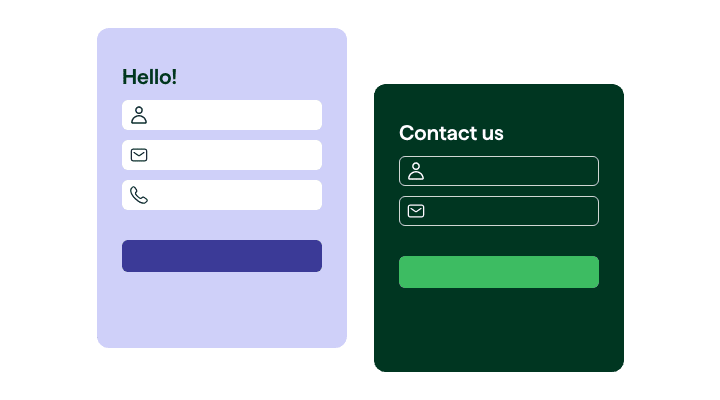Push vs. pull marketing – these two approaches are the foundation of every successful marketing strategy. Master both and they’ll help you consistently fill your sales pipeline.
Push marketing helps you generate immediate visibility and sales, while pull marketing helps you build long-term trust and loyalty. The real power, however, lies in knowing how and when to use each.
In this guide, you’ll learn how to combine both tactics to grow your business faster.
Key takeaways for push vs. pull marketing
Push marketing sends your message to prospects, while pull marketing attracts them to your brand.
The most effective marketing plan combines both approaches, using pull marketing to generate interest and trust with a long-term perspective and push marketing to drive growth with a short-term perspective.
To create a successful hybrid strategy, you must understand your customer journey and deploy the right tactics at each stage.
Push vs pull marketing: what’s the difference?
The main difference between push and pull marketing is how you engage with your target audience.
Push marketing is a direct approach to customers. You take your product to them, like using a megaphone to broadcast a message to an audience. The idea is to present your message to people to generate interest and direct sales.
Pull marketing works by bringing customers to you. It’s more like a lighthouse, guiding people already searching for answers or solutions. You create content and a strong brand positioning so customers seek you out independently.
Here’s a more detailed look at how the two types of marketing differ:
Push marketing | Pull marketing |
The goal: To create immediate demand and quick sales | The goal: To build a loyal audience, generate referrals and create long-term brand value |
The approach: Show an audience a promotional message (outbound marketing) | The approach: Attract an audience by providing helpful resources (inbound marketing) |
The communication: Flows one way, from the business to the customer | The communication: Is a two-way conversation that encourages engagement |
The focus: Your company’s brand identity and products | The focus: Helpful content and the customer’s needs |
It helps to look at the specific marketing tactics involved to see how these theories play out. First, consider the outbound methods of push marketing.
When to use push marketing (+ examples)
A push marketing strategy is the right choice when you can’t afford to wait for customers to find you.
It’s a proactive approach that helps you achieve business goals, especially when you need to build sales momentum quickly.
Push marketing is most effective in three key situations.
1. Driving immediate action and quick wins
An outbound push is the best way to get results when you have a time-sensitive goal.
The main strength of push marketing is speed. It can create a sense of urgency and encourages potential customers to act immediately, which is ideal for hitting short-term sales goals.
Here are some examples of how push marketing helps in specific business scenarios:
When to use push marketing | Why? |
Launching a new product or feature | You must build buzz from a standing start and get your first wave of users |
Running time-bound promotions | You have a special offer to make before the deadline expires |
Hitting crucial sales targets | The end of the quarter is approaching and your team needs to acquire new customers to meet targets |
Here are two examples in practice:
Social media advertising. A SaaS company runs some pay-per-click (PPC) display ads offering a discount for new customers. The ads appear in the LinkedIn feeds of professionals who fit their ideal customer profile, pushing them to a purchase decision.
In-store promotions. Discounts, product placement, or free samples to drive direct sales and brand awareness in stores, potentially as part of a time-bound campaign across multiple channels
In both cases, the goal is to trigger an immediate response. It could be a purchase, a click, a sign-up or a booked meeting – anything that will generate measurable results quickly.
While many modern push tactics are digital, traditional marketing methods are still effective for specific industries.
For example, consider Fenty Beauty’s 2017 launch. To make an impact in a crowded market, the brand pushed teasers and announcements to Rihanna’s massive social media following.
Following this, it launched simultaneously in 17 countries, backed by strategic partnerships and in-store displays with major retailers like Sephora.
The campaign reportedly generated an estimated $100 million in sales within its first 40 days, proving that a strong push can create instant market dominance.
2. Building brand awareness from the ground up
Push marketing lets you create initial demand and introduce your brand to an audience that’s not yet aware of your solution.
When your business is new, customers don’t know to look for you. A push marketing promotional strategy is essential in these situations:
When to use push marketing | Why |
You need to get your new business’s name in front of investors, potential customers and the media from day one | |
Entering a new market or region | You have to educate a new audience about who you are and what problem you solve |
Introducing an innovative solution | People can’t look for a solution if they don’t know that one like yours exists |
In practice, these awareness-building efforts might include tactics such as:
Podcast sponsorships. A new financial services company sponsors a popular business podcast. An ad read introduces the startup to thousands of listeners, pushing the brand name out to a relevant audience.
Industry trade shows. An IT company sets up a booth at a conference. Engaging attendees and offering sales demos allows it to push its solution to a concentrated group of potential buyers.
The objective here is not necessarily an immediate sale, but to plant a seed and make your brand visible so customers can find it later.
3. Targeting specific high-value accounts
Push marketing lets you target specific high-value accounts with personalized messaging.
This targeted approach is ideal in scenarios like these:
When to use push marketing | Why |
Managing a long and complex sales cycle | The customer journey needs multiple touchpoints with different stakeholders. |
Selling to a particular customer demographic | You know exactly which companies and job titles to reach and can contact them directly. |
This marketing approach leads to some of the most targeted tactics, such as:
Engaging on social media with target companies: An enterprise software company identifies 50 target companies and uses LinkedIn to engage with them. This can be combined with other activities, e.g., hosting invite-only virtual roundtables.
Highly targeted advertising: Display ads & retargeting campaigns targeted to specific job titles, industries, locations etc.
When to use pull marketing (+ examples)
Pull marketing is a long-term approach that helps you build a trusted brand that people find when they have a problem.
Instead of pushing messaging to customers, you encourage them to come to you with valuable content and experiences.
The pull approach in marketing is most effective in these three situations.
1. Building a trusted brand and long-term assets
A trusted brand and durable marketing assets enable sustainable business growth. They often outlast short-term tactics and compound in value over time.
Because your content works around the clock, it helps establish your company as the go-to expert in the field. Unlike a paid ad that vanishes when you stop paying, a helpful blog post or guide attracts qualified leads for years.
Pull marketing is essential in situations like:
When to use pull marketing | Why |
Differentiating your company in a crowded market | You build trust and stand out by consistently providing expert guidance and insights. |
Establishing thought leadership | You become the authoritative source in your industry, attracting high-quality prospects. |
Creating evergreen marketing assets | You invest in content that generates traffic and leads long after you publish it. |
In practice, building these assets might include these examples of pull marketing:
Writing in-depth blog posts. A software company writes a comprehensive guide to processes, strategies, techniques etc. It ranks on Google, attracting users trying to improve their processes.
Hosting webinars and workshops. A project management software company hosts a free monthly webinar on productivity hacks for remote teams. It builds an email list and establishes the company as an expert.
These efforts aim to build a library of content that continuously attracts your target customer base over time.
For instance, consider Ahrefs, an SEO software company. Instead of spending heavily on paid ads, it focused on creating in-depth blog posts and video tutorials that solve its audience’s problems.
This strategy worked remarkably well. Ahrefs grew its blog traffic by 1,136% over a few years, going from 15,000 monthly visits to hundreds of thousands. It only publishes around two weekly posts, but each article targets topics people actively search for on Google.
Its content attracts qualified traffic years after publication, proving that pull marketing creates evergreen assets that work around the clock.
2. Capturing high-intent leads
Pull marketing captures prospects who already know they have a pain point and are actively searching for solutions.
Your goal is to be the best and most visible answer they find. If you succeed, you’ll connect with people who are interested in what you have to offer.
Here’s when this approach is most effective:
When to use pull marketing | Why |
Your audience uses search engines to research | You can capture traffic from people looking for answers related to your product. |
The customer journey is research-heavy | You provide the information leads need at an early stage, guiding them toward your solution. |
You need to generate qualified leads more efficiently | Since leads who find you have already identified their needs, they come pre-qualified. |
Here are two examples of how to capture customers who are already looking for you:
Search engine optimization (SEO). An accounting software firm creates a high-quality small business invoicing template optimized for search engines. The page ranks on Google, capturing thousands of potential customers looking for that solution.
Customer reviews and case studies. Your company encourages happy customers to leave reviews on sites like G2 or Capterra. When potential buyers research competitors, the positive word-of-mouth pulls them toward choosing your product.
These tactics work by aligning your approach with customer intent. You’ll attract prospects much further down the sales funnel who are closer to making a purchase.
3. Nurturing an audience and building community
Pull marketing keeps leads engaged and builds lasting relationships after you attract them.
Since you provide ongoing value, you can turn one-time visitors into long-term relationships. You transform your marketing efforts into an ongoing brand loyalty machine.
This long-term engagement is helpful for scenarios such as:
When to use pull marketing | Why |
You have a long sales process | You must stay top-of-mind by providing consistent value until the prospect is ready to buy |
Customer loyalty is a key goal | You build a relationship with your audience, meaning they’re more likely to choose and stick with you |
You want to build a brand following | You create a community of fans who engage with your content marketing and advocate for your brand |
This approach includes tactics like:
Email newsletters. A B2B marketing company sends a weekly newsletter with curated tips, industry news and case studies. In this way, it keeps its brand in its subscribers’ inboxes, nurturing them until they’re ready to buy.
Social media management. A company shares daily tips and tutorials on Instagram. It creates an influencer marketing program, where trusted figures in the industry advocate for the brand. Over time, it builds a community that turns to the company for expert advice.
These strategies build trust and loyalty, which lead to sustainable business growth.
How does the Pipedrive CRM help me run effective marketing campaigns?
The Pipedrive CRM enables you to run powerful email campaigns with Pipedrive Campaigns and helps you convert website visitors that are driven by your marketing campaigns into leads with webforms and website chats.
In addition, Pipedrive acts as a central hub to empower collaboration between your marketing and sales teams - and to create seamless customer journeys and a great customer experience.
Pipedrive email marketing software
A carefully crafted email campaign goes a long way. Build, send, automate and analyze email campaigns with Pipedrive Campaigns and create seamless workflows by combining CRM and email marketing software.
Email builder: With Campaigns by Pipedrive, you can either choose from a range of out-of-the-box free email templates, import pre-existing HTML templates or use a drag-and-drop email editor in the email marketing software, create an email from scratch or modify an existing one from our template editor.
Email segmentation: With Campaigns’ email segmentation tool, you can filter your recipient list based on campaign data, interactions etc. and send targeted emails to make sure the right message gets delivered to the right people.
Email analytics: Campaigns by Pipedrive allows you to deep dive into your data through the campaign reports and insights feature. Discover which campaigns win the hearts of your audience with real-time reporting.
Email automation: Campaigns by Pipedrive offers a workflow automation feature, meaning you can trigger emails to be sent out automatically, e.g. for nurturing campaigns and other email sequences.
Capture leads with Pipedrive

Convert traffic generated by your marketing campaigns into leads on your website with Pipedrive’s tools for lead capture.
Chatbot: Pipedrive’s Chatbot acts as a tireless team member who instantly engages your website visitors 24/7. Customize how it looks, the questions it asks and how it replies. Tailor questions on different web pages, and depending on visitors’ answers, qualify them immediately or route them to an available sales rep.
Live Chat: Have available sales reps add a human touch when needed – from anywhere. They can seamlessly pick up conversations started by a Chatbot using the Pipedrive web or mobile app. If your team ever gets too busy, your Chatbot steps in so no leads slip away.
Web Forms: Give your visitors an easy and reliable way to share their contact information with you. Pipedrive’s Web Forms is intuitive to use yet highly customizable, allowing you to share or embed forms in your website or social media and let the leads roll in.
Final thoughts
A winning marketing strategy uses push and pull marketing to balance quick sales with building long-term customer relationships.
Whether launching a new product or scaling an existing company, the right mix of push pull marketing helps you create integrated customer journeys across multiple touchpoints.
Start a 14-day free trial with Pipedrive and see how it can empower your marketing and sales efforts.





